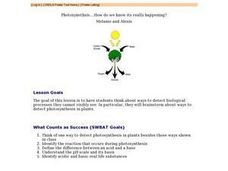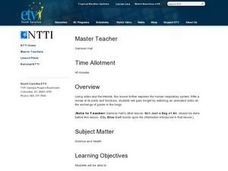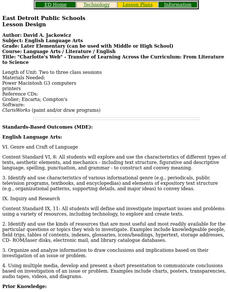Curated OER
Why Invent That?
Students demonstrate an understanding of the text by completing an activity on the advantages and disadvantages of inventing and using a human-powered airplane.
Curated OER
Household ProductsPast to Future
Third graders research and explore the development of household inventions. Groups create timelines which must display the date of each contribution, the inventor or inventors of each contribution, and the cultural background of each...
Curated OER
Salaries
Students are engaged in the study of salaries and how they vary according to different occupations. They conduct research using a variety of resources in order to summarize the earnings potential in the human services field.
Curated OER
VS.6b
Sixth graders explore, analyze and identify the ideas of George Mason and Thomas Jefferson as expressed in the Virginia Declaration of Rights and the Virginia Statue for Religious Freedom. They list and declare the responses stated in...
Curated OER
Sudan Surprise
Learners consider animal migration patterns that have been recently documented in Sudan. They investigate the migratory patterns of animals and discuss how human conflicts and activities affect migratory wildlife populations.
Curated OER
Circulatory and Respiratory Systems Unit - Biology Teaching Thesis
Learners Explain how an increased level of activity translates to cells needing more oxygen and how the lungs supply this oxygen by entering the blood stream. They also can explain that the heart is responsible for moving both oxygenated...
Curated OER
Photosynethsis....How do we know it's really happening? - Biology Teaching Thesis
High schoolers think of one way to detect photosynthesis in plants besides those ways shown in class. They identify the reaction that occurs during photosynthesis. Students define the difference between an acid and a base. They identify...
Curated OER
Keeping Your Heart in Good Shape: What are the Benefits? - Biology Teaching Thesis
Students name the main parts of the heart and what events occur there. They write a reaction that contains complete sentences, and uses proper spelling and grammar, after viewing a video. Students define the following terms: contraction,...
Curated OER
Measurable You!
Conduct guided experiments and discussions while collecting anthropometric measurements. Your class will explore impact of experimental errors in a scientific system, and explain their observations/findings in writing. An introduction to...
Curated OER
Antibodies and the Immune Response Lesson Plans - Biology Teaching Thesis
Students are introduced to bacteria and their role in biology and finishes with a lab experiment that focuses on antibiotics. They are given an overview of the important concepts involving bacteria and their potential resistance to...
Curated OER
Bacterial Transformation: Laboratory Experiment
Students participate in a group lab in which they complete the process of bacterial transformation. If lab procedures are followed correctly, Students see their results in a few days...bacteria glowing green.
Agriculture in the Classroom
Understanding the Columbian Exchange Through Old World and New World Foods
If you're interested in teaching your class about the impact of the Columbian Exchange on contemporary society, this is worth a look. The plan begins with an introduction to the topic, which stems from a cell phone poll...
Curated OER
CO2 Blow Out!
Fifth graders determine that carbon dioxide is a gas given off during respiration and that oxygent is the gas that is absorbed during respiration. They determine the air capacity of the lungs.
Curated OER
Bacterial Transformation
Students discuss a bacterial experiment they previously performed and complete a pre-assessment. They participate in a lecture discussion given by the teacher through PowerPoint and then complete a cartoon worksheet and post-assessment.
Curated OER
Change Over Time Essay: Women's Rights in Korea
Students examine the state of women'srights in Korea. In this women's issues lesson, students analyze the content of 3 provided articles and compose essays regarding the Korean Women's Movement.
Curated OER
DNA Fingerprinting
Pupils discuss methods used by forensic scientists and the basics of DNA and how it can be used to identify an individual after reading an article from The New York Times.
Curated OER
Antibiotic Resistance
Students using the scientific method, study bacteria as a covering surface of the earth in many forms. They discover that not all bacteria is bad and introduce the topic of antibiotic resistance. Science Fair expectations are addressed.
Curated OER
Population Biology
Students define the following terms: predation, competition, carrying capacity and population. They can explain the patterns of growth and the limitations of growth. Students explain the difference between density-dependent and...
Curated OER
The Right Ratio of Rest: Proportional Reasoning
Young scholars see how NASA scientists are studying the circadian timing system to improve astronaut's physical and mental tasks while working in space. They demonstrate how fractions, decimals, and percents are related.
Curated OER
Scatter-Brained
Seventh graders graph ordered pairs on a coordinate plane. They create a scatterplot. Additionally, they determine the line of best fit and investigate the slope of the line. Multiple resources are provided. An excellent resource!
Curated OER
Martin Luther King Jr. Who Is He?
Students describe MLk's leadership of the desegregation movement. Students discuss the meaning of non-violent revolution. Students identify the difference between their lives and those ofcitizens in 1963. Students write a short essay...
Curated OER
Muscle Movements
High schoolers participate in a game to identify major muscle groups in the body and gain an understanding of muscle functions.
Curated OER
"Charlotte's Web" - Transfer of Learning Across the Curriculum: From Literature to Science
Students research and write about the parts of a spider's body using educational software. They draw spiders using computer software.
Curated OER
Laparoscopy Tissue Biopsy
Students describe the anatomy and physiology of a selected organ. They identify the major artery and vein that delivers blood to and from the selected organ and construct an accurate scaled 3D model of a selected organ.























